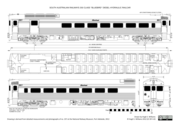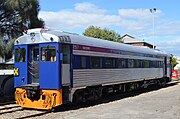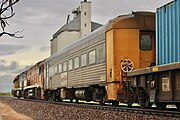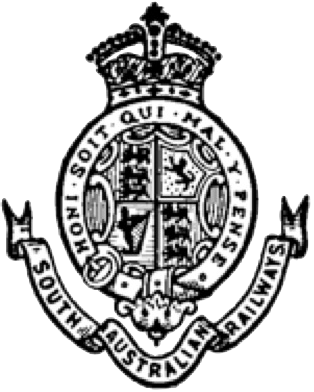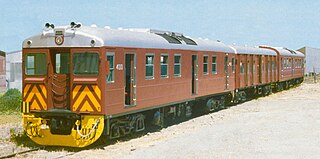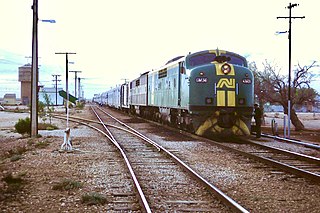- Preserved Bluebird no. 257 operating at the National Railway Museum, Port Adelaide, 2021
- Drawing of South Australian Railways 'Bluebird' railcar 257
- Commonwealth design truck (bogie) on South Australian Railways Bluebird railcar, National Railway Museum Port Adelaide
- Interior of a South Australian Railways 'Bluebird' railcar (250 class second-class passenger power car)
- Bluebird 257 stopped at Jacketts siding, the National Railway Museum's station for broad gauge trains before it was demolished for the Port Dock extension project
- Preserved Bluebird 257 stopped at Jacketts Siding and Barossa Wine Train Bluebirds 251 - 102 - 252 stored at the National Railway Museum, Port Adelaide, 2021
- 257 at the National Railway Museum, Port Adelaide, 2014
- Barossa Wine Train Bluebirds 251 - 102 - 252 stored at the National Railway Museum, Port Adelaide, 2014
- The three types of Bluebird railcars in May 1987 on a charter trip at Telford, South Australia: 250 class power car 256 Kookaburra, 100 class trailer cars 101 Grebe and 105 Snipe and 280 class powered baggage car 282
- Broad gauge "Bluebird" railcar 255. Peterborough Centenary - 9 October 1976
- South Australian Railways Bluebird railcar 260 at Ellen Street railway station, Port Pirie, 1962
- Crew car RZDY 106 (former Bluebird railcar 106 ‘Bittern’) on a Pacific National intermodal train at Snowtown, August 2023.
- Locomotive-hauled car BM259 (former Bluebird railcar 259 ‘Penguin’) stored at Islington Railway Workshops awaiting conversion to a crew car, July 2023.
- Crew car FDDY 5 (former Bluebird railcar 256 ‘Kookaburra’) on an Aurizon grain train at Yumali, April 2023.
- Crew car PDAY 3 (former Bluebird railcar 258 ‘Goshawk’) on a SCT intermodal train at Mallala, October 2022.
- Crew car RZDY 255 (former Bluebird railcar 255 ‘Curlew’) on a Pacific National intermodal train at Long Plains, October 2022.
- Crew car FDDY 2 (former Bluebird railcar 104 ‘Avocet’) on an Aurizon intermodal train at Virginia, September 2022.
- Crew car FDDY 3 (former Bluebird railcar 105 ‘Snipe’) on a One Rail Australia intermodal train at Virginia, October 2021.
| Bluebird railcar | |
|---|---|
 Bluebird 252 "Blue Wren" at Millicent, July 1983 | |
| Manufacturer | South Australian Railways |
| Built at | Islington Railway Workshops |
| Constructed | 1954–1959 |
| Number built | 21 |
| Number in service | 15 (as crew cars) |
| Number preserved | 1 |
| Number scrapped | 5 |
| Fleet numbers | 100-106, 250-260, 280-282 |
| Capacity | 250 class: 56 (some reduced to 52) 100 class: 72 280 class 20 tonnes (20 long tons; 22 short tons) |
| Operators | South Australian Railways Australian National and others |
| Specifications | |
| Car length | 100/250 class: 23.85 m (78 ft 3 in) 280 class: 20.42 m (67 ft 0 in) |
| Width | 2.97 m (9 ft 9 in) |
| Height | 4.17 m (13 ft 8 in) |
| Maximum speed | 112 km/h (70 mph) |
| Weight | 250/280 class: 60 tonnes (59.05 long tons; 66.14 short tons) 100 class: 42 tonnes (41.34 long tons; 46.30 short tons) |
| Prime mover(s) | 2 x Cummins NT-855 |
| Engine type | Diesel |
| Cylinder count | 6 |
| Cylinder size | ? |
| Auxiliaries | General Motors 3-71 cylinder diesel |
| Bogies | Bradford Kendall |
| Braking system(s) | Westinghouse air brakes |
| Track gauge | 1,435 mm (4 ft 8+1⁄2 in) standard gauge 1,600 mm (5 ft 3 in) |
The Bluebird railcars were a class of self-propelled diesel-hydraulic railcar built by the South Australian Railways' Islington Railway Workshops between 1954 and 1959.

